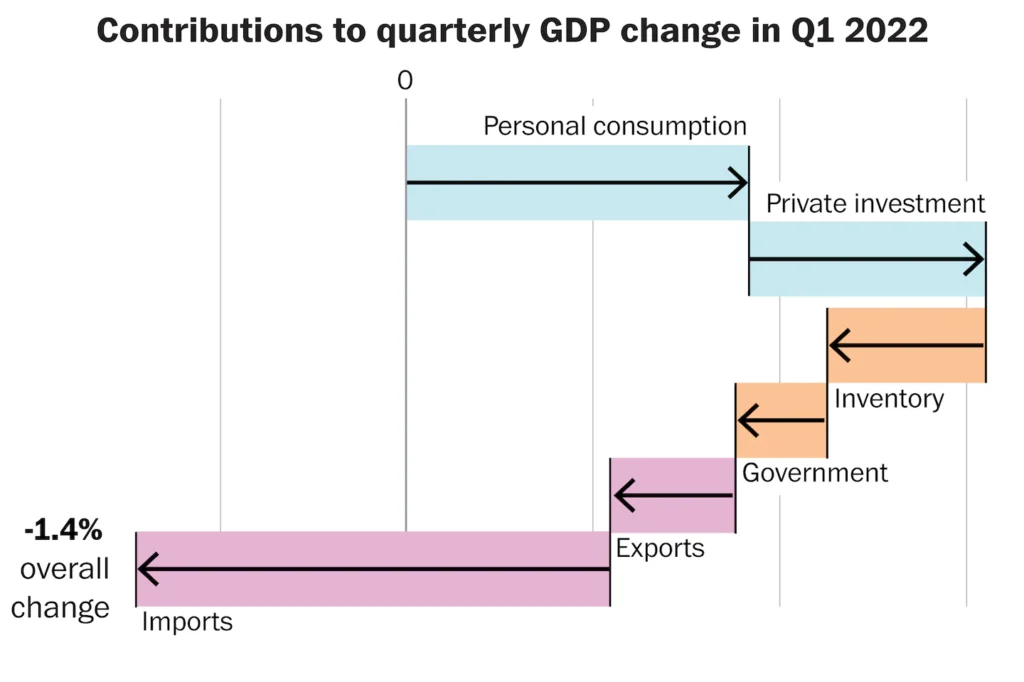GDP fell at a 1.4% annualized rate in the first three months of the year

Contributors to GDP change in Q1 2022
Businesses sold excess inventory from late 2021
Personal consumption pushed GDP up by 1.8 ppt
Imports grew, driving down GDP

Contributors to GDP change in Q1 2022
Businesses sold excess inventory from late 2021
Personal consumption rose, pushing GDP up by
1.8 ppt
Imports grew,
driving down GDP

Contributions to quarterly GDP change in Q1 2022
Businesses sold off excess inventory purchased at the end of 2021.
Personal consumption rose in Q1 2022, pushing GDP up 1.8 ppt
Imports grew, driving down GDP

Contributions to quarterly GDP change in Q1 2022
Businesses sold off excess inventory purchased at the end of 2021.
Personal consumption rose in Q1 2022, pushing GDP up 1.8 ppt
Imports grew,
driving down GDP
-1.4% overall
change in GDP
Here are some ways to think about the economic growth data, against the backdrop of high inflation, a tight labor market and uncertainty about a possible recession that could be in the future.
What’s behind the 1.4% figure?
To recap, U.S. economy abruptly shrank at the beginning of the pandemic, then boomeranged in 2021. Last year, the economy grew by 5.7 percent, the fastest full-year clip since 1984.
Economists didn’t expect the economy would keep that same momentum this year, as federal stimulus programs wore off and the Federal Reserve moved to raise interest rates to slow growth and get a handle on soaring prices. But the negative data on gross domestic product still came as a surprise and masked some signs of strength, like consumer spending.
The shrinkage fueled fears that a recession — defined as two consecutive quarters of negative growth — could be on the horizon, as the Fed tees up as many as seven rate hikes this year. But economists aren’t drawing a straight line between this GDP report and increased risk of a recession. If the economy does contract later this year, it could be for different reasons, like the Fed raising interest rates too aggressively or people pulling back on spending, economists say.
“My big question going forward is, ‘When will they start to slow their pocketbooks?’ But it’s not because of this report,” said Beth Ann Bovino, U.S. chief economist for S&P Global Ratings. “Going forward, will there be a point when people either run out of a buffer, start to feel like they’re dipping too far into their savings or they’re tired of paying higher prices?”
Drop-off in inventory purchases
One of the big reasons for the economy’s first-quarter drop was rooted in what are called retailers’ inventory purchases, which are the goods companies tend to buy before they need them. Retailers often make purchases far in advance, to prepare for things, like the holiday shopping season. And in some cases, companies will stock up on materials if they’re worried about supply chain delays or other issues, like rising prices. That’s what happened in late 2021. Remember all those supply chain snafus? Retailers brought in a lot of goods early to make sure there weren’t shortages during the holidays.
At the beginning of 2022, many of those same companies realized they had plenty of sweaters, toys or gadgets left over and they didn’t need to stock up any more. Inventory purchases by themselves are responsible for a big part of the GDP drop — as much as 0.84 percentage points.
More imports weigh on GDP
The United States didn’t export as many goods in the first three months of the year. On top of that, the country imported a lot more things, in part due to all the different supply chain problems that have been beleaguering companies over the past year, even in the face of high consumer demand. That move widened the trade deficit.
And widened trade deficits play a big role in how GDP is calculated. The GDP report effectively subtracts all the stuff purchased from other countries, which shows up as a major drag on GDP. In fact, the decrease in exports and increase in imports, when taken together, were responsible for 3.2 percentage points of the drop.
“Demand for goods is so strong that Americans are turning to the international economy to satiate demand,” said Joe Brusuelas, chief economist at RSM. “There was an increase in demand for goods, and that right there, in a nutshell, is the problem.”
International trade figures also tend to get serious revisions after initial GDP estimates. More specific data comes out next week. For now, though, “the domestic side of the equation was strong,” Bovino said.
The other major forces in the economy
The GDP report comes as policymakers and economists are grappling with two major issues in the economy: soaring inflation and a tight labor market.
Inflation has risen to the highest levels in 40 years, with prices rising 8.5 percent in March compared with the year before. The Fed is racing to get control of rising prices before they become even more embedded in the economy. Republicans are hammering the Fed for being too slow to respond and are placing much of the blame on Democrats’ sprawling stimulus efforts from last year.
Meanwhile, the job market has shown tremendous strength since 20 million jobs fell out of the economy two years ago. The unemployment rate remains remarkably low — 3.6 percent — and the job market has been a huge talking point for the Biden administration. But economists and policymakers also worry the job market is unsustainably hot. There are far more job openings than job seekers, and the mismatch has the Fed trying to tamp down demand for workers without causing people to lose their jobs.

